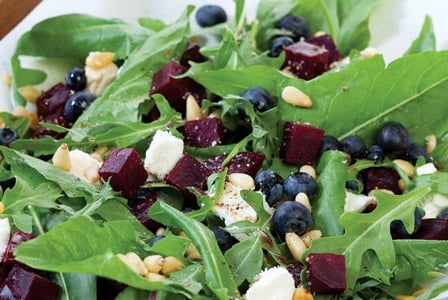
Weeds with benefits! Our Summer Dandelion Salad recipe is brimming with vitamins A, C, and K. Learn how to forage for dandelions.
While children love picking sunshine-bright dandelions for their moms, many adults consider the plants a blight on their otherwise manicured lawns. And recent widespread banning of pesticides has compounded the challenges of stalking these pesky weeds. One solution is simply to eat them.
From the bright flowers down to the dark—almost black—roots, dandelions complement a variety of tasty, and nutritious, foods and beverages. And their reputation as medicinal plants reaches at least as far back as ancient Greece. The dandelion’s official name, Taraxacum officinale, stems from the Greek taraxos meaning disorder, and akos, or remedy.
Traditional uses
In China, dandelions had claimed their spot as herbal remedies for ailments, including liver. kidney, and digestive disorders, by the seventh century. By the 1400s, they had found their way into the cuisine of most European countries. The French have feasted on this plant for centuries, calling it dent-de-lion because its sharp, serrated leaves resemble lion’s teeth. Hence the anglicized dandelion.
It may be native to North America or have arrived with European settlers—the debate continues. But it’s here to stay and can be found across Canada.
Store-bought greens
“We sell dandelions year-round, as long as they’re available,” says Carmen Lauretta, manager of produce at Loblaws in Toronto’s St. Clair-Forest Hill. Although most come from the United States, “dandelions are particularly popular when we get Ontario home-grown.”
Harry Liu, produce buyer at Whole Foods Market in West Vancouver, also stocks dandelions all year. “We sell only organic,” he says. These cost slightly more than their nonorganic cousins, which hover between about 99 cents and $2.99 for a bunch of three to four stalks; either way, a good budget choice. Of course, dandelions cost nothing to yank from our own backyards.
Serving suggestions
If picked when their shiny, green leaves first appear in spring, dandelions add a sharp zing to salads. However, the word bitter dominates descriptions of their taste. To mute bitterness, recipes recommend blending the leaves with other vegetables—lettuce, endive, and shallots—then adding nuts, cheese, and vinaigrette dressing. The crisp leaves also deliver a sandwich with bite when placed between buttered whole wheat slices and sprinkled with salt, pepper, and lemon juice.
Blanching them in boiling, slightly salted water tempers the taste when they’re really bitter. Sautéeing them for two to four minutes more in olive oil, lemon juice, and crushed garlic produces a result similar in flavour and texture to spinach. Tossing the cooked dandelion leaves into vegetable and pasta dishes adds a fresh twist to everyday menus.
Although dandelion petals create a colourful, crunchy treat when lightly sautéed in oil, they draw more attention for the pale, moderately alcoholic wine made by combining them with sugar and lemon juice. And if coffee lovers feel the brew from roasted dandelion roots lacks some of the kick of caffeinated coffee, they may find it easier on the nerves.
Nutritional benefits
A refreshing tea from leaves steeped in boiling water for four to six minutes and sweetened with a teaspoon of honey lays claim to medicinal properties that enhance digestion.
According to Health Canada, 1 cup (250 mL) of raw dandelion greens equals one daily serving of vegetables. And they’re packed with vitamins, including A, C, and K, and minerals such as calcium, iron, and potassium.
Health Canada lists dandelion roots and leaves among its drug and health products, as a diuretic. It does, however, warn people with liver, gallbladder, or bowel afflictions against this use.
And another note of caution: the French also call this plant pisenlit, meaning wet the bed, a sly nod to its strong diuretic effect. So it’s best not to reach for that dandelion sandwich or leftover salad to satisfy cravings for a midnight snack.
Salad Recipe
- Summer Dandelion Salad
Foraging for dandelions
Best spots
- meadows, pastures, open spaces
- areas cleared of wild vegetation—dandelions thrive in cultivated soil
- crevices—as the wind carries their seeds, some hit walls and fences, drop, and take root; they’re small and can settle into tight spaces
- shadier areas, where growth is delayed, harbour younger, less bitter leaves
Best times
- springtime, before or as the dandelion flowers bloom
- late fall—after the first frost, the plant’s bitterness diminishes
- if picked between these times, blanch the leaves to temper bitterness
- sunny days—flowers close during rainy, cloudy weather so they’re harder to spot
Best to avoid
- areas where dangerous chemicals, pesticides, or herbicides may have drained into the soil—even your own lawn if you’ve used chemicals on it
- roadsides that could be contaminated by exhaust fumes and winter salting
- parkland where dogs and other animals run free; always wash leaves thoroughly, twice




























